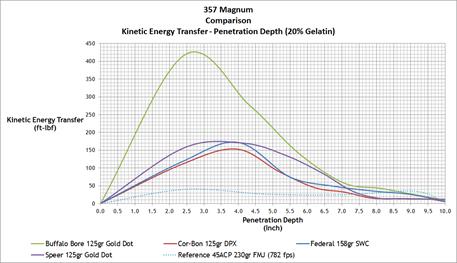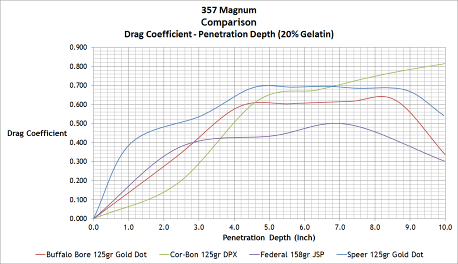Brass Fetcher Ballistic Testing: 357 Magnum
357 Magnum requires moderate skill to shoot in a medium frame revolver and is an experts gun in a small frame revolver intended for concealment. A large frame revolver in this cartridge is among the most versatile handgun that can be purchased. 38 Special cartridges can be safely fired in a 357 Magnum firearm and the nature of a revolver allows for normal gun function with any projectile, including ‘rat shot’ for pest control.
The average 357 Magnum (2" barrel) JHP kinetic energy transfer per inch of penetration is 23 ft-lbf/inch.
Compared to the average 9mm Luger +P (3" barrel) JHP kinetic energy transfer per inch of penetration which is 23 ft-lbf/inch.
The average 357 Magnum (4" barrel) JHP kinetic energy transfer per inch of penetration is 33 ft-lbf/inch.
Compared to the average 9mm Luger +P (4" barrel) JHP 124gr kinetic energy transfer per inch of penetration which is 30 ft-lbf/inch.
If you own a revolver for self-defense, hopefully it is chambered in 357 Magnum. Such a firearm gives you the option of teaching a new shooter using 38 Special and you can use 357 Magnum loads for relatively cheap and easy practice ammunition. Notice please that I did not say that you can practice with 38 Special ammunition and use 357 Magnum ammunition for self-defense. History has shown that you will fight like you train, so it is wise to train like you want to fight. Using hot ammunition during practice will allow for more rapid and accurate follow-up shots, with high performance ammunition, if you ever have to shoot under stress.
A typical 357 Magnum load will propel a 125gr bullet to 1400 ft/sec. Much faster ammunition is available but the recoil must be increased moderately to achieve the greater performance.
357 Magnum was originally invented as a high-performance replacement for 38 Special and 38 Super as used in law enforcement at the time. It was known even then that many law enforcement encounters would take place in and around cars. Sometimes body armor was involved, which has less trouble stopping large diameter, slow-moving bullets than it does stopping smaller and faster bullets. These ballistic vests were made of thick layers of cotton cloth and were effective at stopping handgun bullets previous to the 357 Magnum.
Today this is not the case. With synthetic fibers like Kevlar and Dyneema in use, a handgun requires a specially-designed armor piercing bullet to be able to pierce soft body armor. Such a round will permit guns such as the 45 ACP to pierce soft body armor and will greatly enhance the performance of 357 Magnum above and beyond any soft body armor available today. Whatever the original design criteria of the 357 was, it is very useful also for hunting up to medium game animals.
A particularly fascinating feature of the 357 Magnum is that it is effective in a handgun and reaches almost carbine-like performance out of a rifle length barrel. Data from Ballistics By The Inch reveal that a 125gr bullet propelled at 1500 ft/sec from a 4” barrel will obtain approximately 2000 ft/sec out of the muzzle of a 18” barrel. While the ballistic properties of 357 Magnum bullets are very much not like a rifle, the 33% increase in velocity will allow humane hunting to at least 100 yards and will repulse attackers at 200 yard distance with proper aiming.
Multiple-projectile loads have been tried at various times in the past in an effort to increase hit probability and increase terminal effectiveness. Perhaps the most well-known example of this was part of Project SALVO from the US Army. In the 1960s, Colt introduced the Salvo Squeezebore concept in an attempt to increase hit probability and increase the likelihood of FMJ bullets tumbling inside of the target. Part of the reason for these programs is that the most militaries are signatory to the Hague convention which disallows the use of bullets that are ‘calculated to increase suffering’ of the target. The Hague Conventions don’t say anything about shooting multiples of these “happy bullets” per trigger pull.
At left is a recent product that launches multiple projectiles from a 38 Special cartridge case. Duplex and triplex loads can function satisfactorily from a 38 Special but would be more successful out of the 357 Magnum due to the greatly increased kinetic energy.
If I could own only one handgun it would be a 357 Magnum revolver with 4” barrel. Under no circumstances would I own a 357 Magnum snubnose. A snubnose revolver typically has a barrel length of 2” or less and does not generate enough muzzle velocity to put the 357 Magnum in the performance arena of the 9mm Luger. What the snubnose does generate, however, is severe recoil and gas pressure at the muzzle. The increase in gas pressure will make the gun painful to your hearing and will produce a blinding (to the shooter) fireball during low-light shooting.
Owning a 4” barrel will give you a good portion of the muzzle velocity available with this cartridge. This will produce more than enough soft target lethality to reliably deter a human attacker.
Since I like to deal in facts and not conjecture, I evaluated a 357 Magnum snubnose using 38 Special and 357 Magnum ammunition. In order to avoid controversy I used the same ammunition type for both calibers and I used the same weapon, a Smith and Wesson M&P340. The ammunition is from the same manufacturer for both calibers and is labeled as being designed for short-barreled guns.
The video at left should give you some evidence with which to decide whether a 357 Magnum snubnose is worth it to you.
If you are fortunate enough to live in an area with a low density of cities and a high population of potentially dangerous animals like bear, you might find that a hot 357 Magnum bullet (with minimal expansion) may make the difference between life and death if attacked by such an animal. The side benefit is that a 4” revolver 357 Magnum should be reasonably concealable. Larger handguns like the 44 Magnum are more effective but even less concealable if you have to drive into town.
My ammunition recommendation for this caliber is to carry the hottest 125gr JHP that you can shoot. Only carry the ammunition that expands reliably and does not fragment when shot out of your firearm. It is economically advantageous for a bullet manufacturer to make one bullet that can be used over a wide range of velocities. This means that it can be used in a wide variety of cartridges. In some cases, 38 Special cartridges do not propel bullets designed for 357 Magnum velocities, to a velocity high enough to expand. What you have then is an expensive FMJ cartridge. One the other side of the coin, hot 357 Magnum loads (or standard velocity loads shot out of carbines) can possibly propel the bullet too fast. Excessive fragmentation and shallow penetration is the result in this case. Only experimentation with your gun can tell for certain.
You may be interested to watch the video below, which is a comparison of four different 357 loads : a 125gr JHP loaded to moderate velocity, a 125gr JHP loaded to higher performance specifications, a 125gr DPX bullet and a 158gr JSP.

